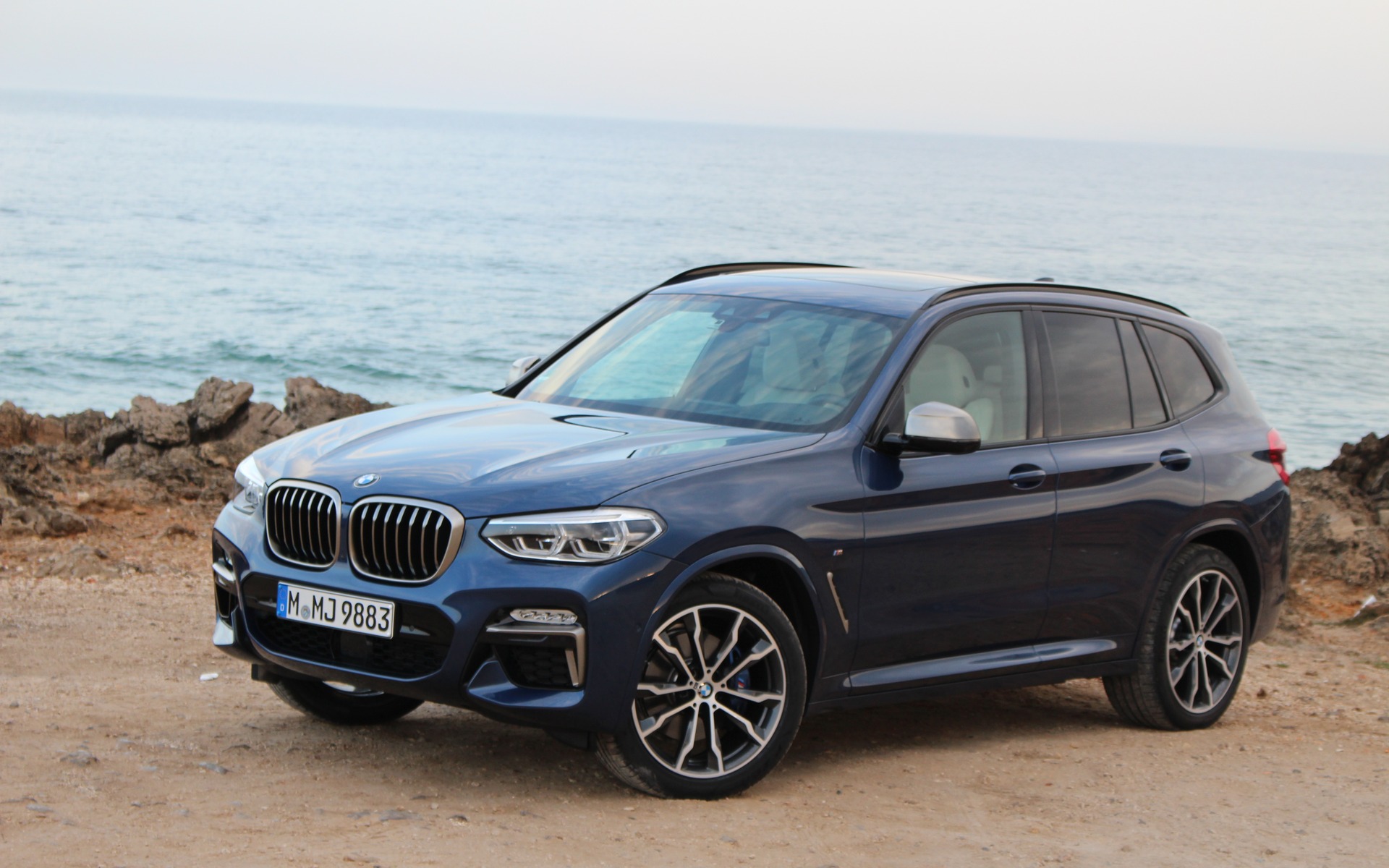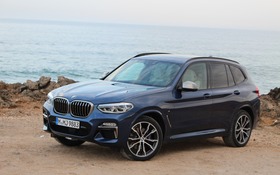2018 BMW X3: Improved in all the Right Places

| Strong points |
|
|---|---|
| Weak points |
|
SINTRA, Portugal – The third-generation X3 will arrive in Canadian dealerships late this year, and although it looks quite similar to the outgoing model, the brand’s compact crossover has changed quite a bit.
The 2018 BMW X3’s overall shape is obviously an evolution over the previous generation, and it’s easy to criticise designers for not taking any styling risks. There is a fine line between transforming the shape of a vehicle to make it look contemporary, but not too much so the loyal customer base doesn’t feel offended. Add a brand’s mandatory styling cues to the equation, such as BMW’s trademark kidney grille, for example, and the task at hand becomes all that more challenging.
- Also: 2018 BMW 640i xDrive Gran Turismo: The New Face of the 6 Series
- Also: BMW Concept X7 iPerformance: A First Ever SUV from BMW i!
However, after discussing with 32-year-old Calvin Luk, responsible for the new X3’s exterior design, there’s a lot of thinking that went behind the SUV’s redesign. At the front, the grille is taller and is no longer connected to the headlight clusters, making it more prominent. The round fog lamps have been replaced by flatter, LED-type units and the bumper air intakes are more aggressive. At the rear, the taillights are similar in shape, but have been given a 3D-style design for a more detailed effect. The biggest change, although it isn’t immediately noticeable, is the bulge added right below the X3’s greenhouse, giving it a more muscular, broad-shouldered stance.
Inside, the X3’s instrumentation layout is typical BMW, but the overall design has been modernised with silver trim and switchgear. The dash top sweeps downwards while the infotainment system screen is now perched on it, giving a greater sense of airiness. Said screen now measures 10.2 inches and is touch-sensitive, and the BMW Gesture Control technology is now available as well. The latest version of the iDrive system has a few menu layout changes, but remains easy to use thanks to the multifunction knob and its surrounding buttons.

The 2018 BMW X3 is 59 millimetres longer compared to the 2017 edition, and rides on a 54-mm longer wheelbase. Cargo space is unchanged at 550 litres with the rear seatbacks up, and 1600 mm with the seats folded flat. While we initially though the extra wheelbase would benefit rear-seat room, it’s actually the front occupants that benefit from more legroom, in addition to more head and elbow room.
The panoramic sunroof—included in the optional Premium Package—is now 250 mm longer, so that’s good, too. BMW says the acoustic glass windshield now makes the cabin much quieter. It is quiet, that’s for sure, but by how much would require us to drive a 2017 back to back with a 2018 and see the difference.
Like with the current BMW X4, whose redesign will likely follow next year, the new X3 will now be offered in a performance-oriented M40i variant, set to rival the Mercedes-AMG GLC 43 and the Audi SQ5. It’s equipped with a turbocharged, 3.0-litre inline-six that dishes out 355 horsepower and 369 pound-feet of torque. It’s managed by an eight-speed automatic transmission, and as usual, the company’s xDrive all-wheel drivetrain is also included in every X3.
The M40i stands out with its standard 21-inch alloy wheels as well as M Performance-specific touches such as dark chrome exhaust tips, more aggressive lower-body trim. An M Performance suspension and steering calibrations are included as well.
On the roads and highways of Portugal, the X3 M40i quickly flaunted its newfound character. Engine torque peaks between 1520 and 4800 rpm, so it’s always there when you need it. BMW claims a 0-to-100 km/h time of 4.8 seconds, which we have no reason to doubt after flogging the M40i in Sport and Sport Plus modes. When the latters are activated, the exhaust system also pops and burbles during full-throttle upshifts and when we lift our foot from the gas pedal. Music to our ears.
The ride is slightly harsh, although less so in Comfort mode, but that is to be expected in the M40i. We must admit that the previous day, we were driving on the same roads aboard the silky-smooth 2018 BMW 6 Series Gran Turismo, so that may have clouded our judgement. Just a little.

We also hopped in a diesel-powered X3 and hit the off-road course set up by BMW. What looked like a simple trail to the cottage at the start became a much more challenging path, creeping up and down the mountainside while getting a spectacular view of Portugal’s landscapes.
As we crossed over some fairly serious ruts on the trail, we could feel the xDrive system briefly spin a tire, and get the vehicle moving along by sending power to the wheels with the most traction. No driver intervention is required here, but we can activate the hill descent control system when the trail is steep. By flicking the cruise control rocker switch, we can set a fixed speed at which the vehicle will limit itself to, allowing us to concentrate on safely steering the vehicle.
The 2018 BMW X3 xDrive30i will be the base trim in Canada. It will feature a new turbocharged, 2.0-litre four-cylinder engine that develops 248 horsepower and 258 pound-feet of torque. Again, an eight-speed automatic and xDrive are part of the package. According to BMW, and despite the 172-pound (78-kg) weight gain over last year’s X3 xDrive28i and its 241-hp engine, the new X3 zips from 0 to 100 km/h in 6.3 seconds, or two tenths of a second quicker.
Fuel economy ratings are not yet available, but the 2017 X3 with the 2.0L engine boasted city/highway figures of 11.1/8.5 L/100 km. The 2018 xDrive30i variant should be pretty close to that.
For now, there are no plans to bring a diesel-engined X3 to Canada, which means the current xDrive28d variant won’t be replaced. On the other hand, a fully electric X3 should arrive in 2020, and a high-performance X3 M has been confirmed as well, though exact specifications haven’t yet been disclosed. However, to rival the likes of the Alfa Romeo Stelvio Quadrifoglio and Mercedes-AMG GLC 63, it would have to produce close to 500 horsepower. We’ll see.
Pricing for the 2018 BMW X3 starts at $48,000 before freight and delivery charges, a modest increase over the 2017 model. The M40i is listed at $61,500, or roughly the same as last year’s xDrive35i with the M Sport package. In comparison, a Mercedes-Benz GLC starts at $42K, while an Audi Q5 is $45K and up.
As is often the case during a model redesign, the X3’s is more of an evolution then a revolution. However, the newfound features, the more refined cockpit design and the availability of a performance-oriented M40i variant help the SUV stay competitive in a growing market segment. And with new powertrains in the pipeline, the X3 should get a lot more attention in the next couple of years.











